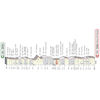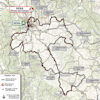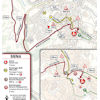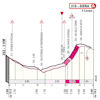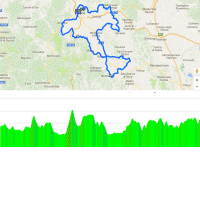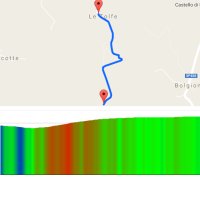Starting from Siena, the riders enter a race with medieval characteristics. They navigate 63 kilometres of Tuscan gravel, or ‘sterrati’. There are eleven sectors, the first of which is a solid way to get warmed up to the hardships ahead. It’s 2.1 kilometres long and perfectly straight.
Sector 2 serves the pilots a more accurate taste of what’s ahead – 5.8 kilometres long and occasionaly kicking up to 10%.
Following two flat to descending sterrati – respectively 4.4 and 5.5 kilometres – the Strade Bianche tackles its second climb. This one is on tarmac and leads to the fortified town of Montalcino.
On to sterrato 5. An enchanting dust road in itself, with fields and forest left and right, this is – at 11.9 kilometres – the longest sector of the day. Moreover, after just 1 kilometre of tarmac the hardship continues on the 6th gravel road. This one is 8 kilometres long and brings something extra to the mix. It meanders on winding roads through the Tuscan countryside and includes both climbing and descending.
By now, the riders are halfway. After roughly 11 kilometres on smooth asphalt the 7th sterrato appears. It’s 9.5 kilometres long and runs mostly uphill. It goes up and down in the first part and ends with a twisting climb before meeting the tarmac again. Last year, Mathieu van der Poel, Wout van Aert, Tadej Pogacar, Julian Alaphilippe, Egan Bernal, Tom Pidcock, Michael Gogl, and Quinn Simmons distanced the rest of the field on this sector. Moments later the young American punctured and lost contact.
At kilometre 130 the endgame begins on the Monte Sante Marie climb. At 11.5 kilometres, sector 8 is arguably the toughest of all sterrati at the Strade Bianche. With a lot of uphill the strip also features some tricky descents.
Following a lumpy intermezzo on asphalt – which may sound better than it actually is – the riders tackle the first of the last three unpaved sectors. Sterrato 9 is 800 metres long and pepped up with a double digit gradient ramp before hitting the tarmac again in Vico d’Arbia.
A rolling stretch continues onto the Strade di Colle Pinzuto, which is a 2.4 kilometres sector that will weary the legs still further. It begins with a 15% ramp and keeps climbing gradually all the way until the end.
The final gravel road is a 1.1 kilometres toil, opening with a short descent and closing with 18% gradients. Last year, Van der Poel tried to shake off his rivals on this sector, but Alaphilippe was glued to his wheel, while Bernal re-joined the two on the ashalt.
When Strade Bianche reaches the village of Le Tolfe there are still 12 kilometres to go. The winding roads of Tuscany favour attackers in this phase, as chasers will have difficulty pinpointing them.
With 5 kilometres remaining the road flies downhill, only to go back up again in the last kilometre. Entering the city walls of Siena, a 16% sector welcomes the riders. A sharp turn to the right, left, and right again. The finish is at Piazza del Campo, Siena’s iconic square resembling a theatre.
Title holder Van der Poel is absent due to back injury. The Dutchman dropped Alaphilippe and Bernal last year on the punchy climb into Siena.
Ride the route yourself? Download GPX Strade Bianche 2022.
Other interesting reads: results and start list 2022 Strade Bianche.
Strade Bianche 2022: routes, profiles, more
Click on the images to zoom
